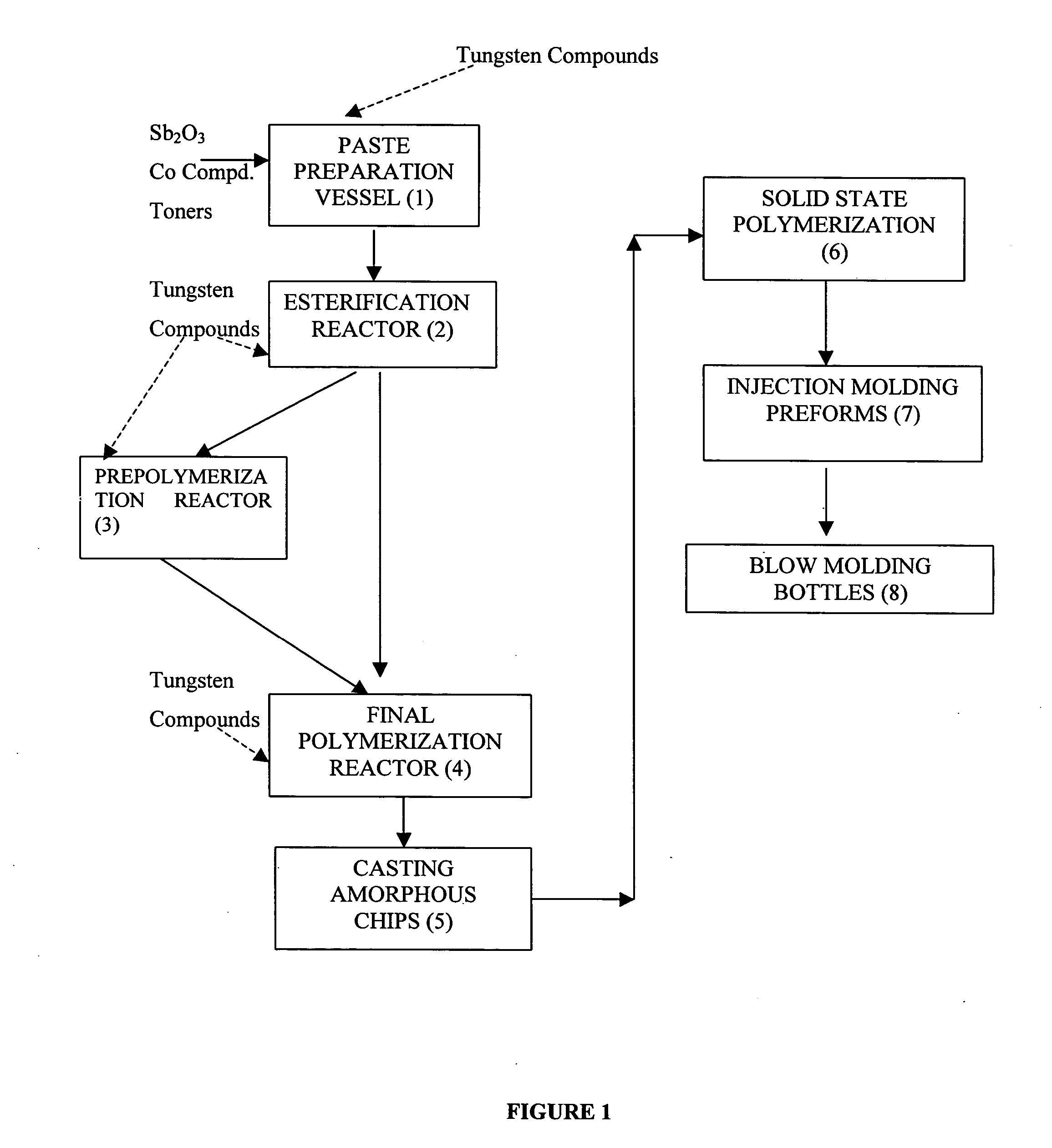Polyester resins with a special co-catalyst for high melt poly and SSP reactivity with enhanced color values
a polyester resin and co-catalyst technology, applied in the direction of synthetic resin layered products, chemical/physical processes, packaging, etc., can solve the problems of difficult to obtain pet of number average molar mass mn greater than, lower generation of acetaldehyde, and reduce solid state polymerization processing time , the effect of improving the product characteristics
- Summary
- Abstract
- Description
- Claims
- Application Information
AI Technical Summary
Benefits of technology
Problems solved by technology
Method used
Image
Examples
example — 1
EXAMPLE—1
[0106] PTA / MEG paste comprising 2215 kg of PTA, 50 kg IPA and 813 kg of MEG was charged to an Esterifer reactor. The paste also contained 683 gm Sb2O3 (230 ppm as Sb), 311 gm, 230 gm Cobalt Acetate (22 ppm as Co), 4.5 gm each of the Red and Blue toners (1.9 ppm each). Esterification was carried out between the temperatures 240 and 268° C. under a pressure of 2.2 bar(g). At this stage the polymer-melt was stabilized with 135 gm TEPA (50 ppm) and 50 gm OPA (50 ppm). After the esterification the prepolymer formed was filtered through a 20 micron filter and transferred to the polyreactor and 60 gm of Tungsten Oxide (WO3) dispersed in 5 litres of ethylene glycol was added. The prepolymer was polymerized by gradually reducing the pressure to 5-15 mbar and increasing the temperature from 268 to 285° C. Towards the end of the process the pressure was further reduced to <1.0 mbar (abs) and the temperature increased to 280-285° C. After the requisite IV was reached as indicated by th...
example 2
[0113] The process of example 1 was repeated except that 60 gms of tungsten carbide powder of particle size ranging from 2 to 6 microns and dispersed in ethylene glycol was added in polyreactor. The results obtained were as follows:
SSP rate:0.022 IV increase / hourL* value79.8b* value:−1.8IV:0.84.
example 3
[0114] The process of example 1 was repeated except that 60 gms of tungsten trioxide powder of particle size ranging from 1 to 5 microns and dispersed in ethylene glycol was added in the paste preparation vessel. The results obtained were as follows:
SSP rate:0.0198 IV increase / hourL* value79.6b* value:−1.3IV:0.83
PUM
| Property | Measurement | Unit |
|---|---|---|
| particle size | aaaaa | aaaaa |
| temperature | aaaaa | aaaaa |
| temperature | aaaaa | aaaaa |
Abstract
Description
Claims
Application Information
 Login to View More
Login to View More - R&D
- Intellectual Property
- Life Sciences
- Materials
- Tech Scout
- Unparalleled Data Quality
- Higher Quality Content
- 60% Fewer Hallucinations
Browse by: Latest US Patents, China's latest patents, Technical Efficacy Thesaurus, Application Domain, Technology Topic, Popular Technical Reports.
© 2025 PatSnap. All rights reserved.Legal|Privacy policy|Modern Slavery Act Transparency Statement|Sitemap|About US| Contact US: help@patsnap.com

